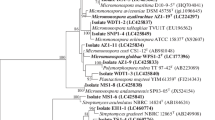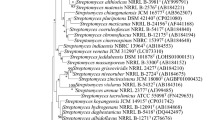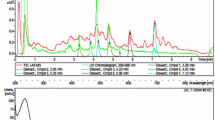Abstract
Some endophytic actinomycetes (120) were isolated from the roots ofAlpinia galanga. Identification of these endophytes was based on their morphology and amino acid composition of the whole-cell extract. Most isolates were classified aStreptomyces sp. (82), with the remainder belonging toNocardia sp. (11),Microbispora sp. (3) andMicromonospora sp. (2). Eight isolates were unclassified and 14 were lost during subculture. The strain identified as endophyticStreptomyces sp. Tc022 strongly inhibitedColletotrichum musae andCandida albicans. This endophyte was cultured, the agar was extracted with organic solvent and the extract was purified on a column of silica gel to give a major component, which was identified to be actinomycin D on the basis of spectroscopic dat Actinomycin D showed antifungal activity againstColletotrichum musae andCandida albicans with the MIC of 10 and 20 mg ml−1, respectively.
Similar content being viewed by others
References
Altschul S.F., Madden T.L., Schaffer A.A. (1997). Gapped BLAST and PSI-BLAST: a new generation of protein database search programs. Nucleic Acids Res., 25: 3389–3402.
Arison B.H., Hoogsteen K. (1970). Nuclear Magnetic Resonance spectral studies on actinomycin D. Preliminary observations on the effect of complex formation with 5′-deoxyguanylic acid. Biochemistry, 9: 3976–3983.
Becker B., Lechevalier M.P., Gordon R.E., Lechevalier H.A. (1964). Rapid differentiation betweenNocardia andStreptomyces by paper chromatography of whole-cell hydrolysates. Appl. Microbiol., 12: 421–423.
Boone C.J., Pine L. (1968). Rapid method for characterization of actinomycetes by cell wall composition. Appl. Microbiol., 16: 279–284.
Brosius J., Palmer M.L., Kennedy P.J., Noller H.F. (1978). Complete nucleotide sequence of a 16S ribosomal RNA gene fromEscherichia coli. Proc. Natl. Acad. Sci. USA., 75: 4801–4805.
Castillo U., Harper J.K., Strobel G.A., Sears J., Alesi K., Ford E.J., Lin J., Hunter M., Maranta M., Ge H., Yaver D., Jensen J.B., Porter H., Robison R., Millar D., Hess W.M., Condron M.A., Teplow D.B. (2003). Kakadumycins, novel antibiotics fromStreptomyces sp. NRRL 30566, an endophyte ofGrevillea pteridifolia. FEMS Microbiol. Lett., 224: 183–190.
Castillo U.F., Strobel G.A., Ford E.J., Hess W.M., Porter H., Jensen J.B., Albert H., Robison R., Condron M.A., Teplow D.B., Stevens D., Yever D. (2002). Munumbicins, wide-spectrum antibiotics produced byStreptomyces NRRL 30562, endophytic onKennedia nigriscans. Microbiology, 148: 2675–2685.
Felsenstein J. (1995). PHYLIP (phylogenetic inference package) version 3.57c. Department of Genetics, University of Washington, Seattle, WA, USA.
Higgins D.G., Bleasby A.J., Fuchs R., (1992). CLUSTAL V: improved software for multiple sequence alignment. Comput. Appl. Biosci., 8: 189–191.
Hollstein U., Breitmaier E., Jung G. (1974).13C Nuclear Magnetic Resonance study of actinomycin D. J. Amer. Chem. Soc., 96: 8036–8040.
Hopwood D.A., Bibb M.J., Chater K.F. (1985). Preparation of chromosomal, plasmid and phage DNA. In: Hopwood D.A., Bibb M.J., Chater K.F., Eds, Genetic Manipulation ofStreptomyces: A Laboratory Manual, F. Crowe and Sons, Norwich, pp. 79–80.
Lackner H. (1971). Zur Seundar- und tertiarstruktur der actinomycine, III Selektiv im (a)- oder (b)-peptidlactonring deuterierte actinomycine C1 (D). Tetrahedron Lett., 37: 2221–2226.
Murashige T., Skoog F. (1962). A revised medium for rapid growth and bioassays with tobacco tissue cultures. Physiol. Plant, 15: 473–479.
NCCLS — National Committee for Clinical Laboratory Standards (1997). Reference method for broth dilution antifungal susceptibility testing of yeasts. Approved standard M27-A. National Committee for Clinical Laboratory Standards, Wayne, Pa.
Otoguro M., Hayakawa M., Yamazaki T., Iimura Y. (2001). A integrated method for the enrichment and selective isolation ofActinokineospora spp. in soil and plant litter. J. Appl. Microbiol., 91: 118–130.
Petrolini B., Quaroni S., Saracchi M. (1986). Scanning electron microscopy investigations on the relationships between bacteria and plant tissues: Comparative techniques for specimen preparation. Riv. Patol. Veg., 22: 7–15.
Sardi P., Saracchi M., Quaroni S., Petrolini B., Borgonovi G.E., Merli S. (1992). Isolation of endophyticStreptomyces from surface-sterilized roots. Appl. Environ. Microbiol., 58: 2691–2693.
Shimizu M., Nakagawa Y., Sato Y., Furumai T., Igarashi Y., Onaka H., Yoshida R., Kunoh H. (2000). Studies on endophytic actinomycetes (I)Streptomyces sp. isolated fromRhododendron and its antifungal activity. J. Gen. Plant Pathol., 66: 360–366.
Shirling E.B., Gottlieb D. (1966). Methods for characterization ofStreptomyces species. Int. J. Syst. Bacteriol., 16: 313–340.
Taechowisan T., Lumyong S. (2003). Activity of endophytics actinomycetes from roots ofZingiber officinale andAlpinia galanga against phytopathogenic fungi. Ann. Microbiol., 53: 291–298.
Taechowisan T., Peberdy J.F., Lumyong S. (2003). Isolation of endophytic actinomycetes from selected plants and their antifungal activity. World J. Microbiol. Biotechnol., 19: 381–385.
Taechowisan T., Lu C., Shen Y., Lumyong S. (2005). 4-Arylcoumarins from endophyticStreptomyces aureofaciens CMUAc130 and their antifungal activity. Ann. Microbiol., 55: 63–66.
Thomas P. (1998). Contribution of leaf lamina of grape nodal microcuttings to rooting, root vigor and plantlet growthin vitro. J. Plant Physiol., 153: 727–732.
Yang X., Strobel G., Stierle A., Hess W.M., Lee J., Clardy J. (1994). A fungal endophyte-tree relationship;Phoma sp. inTaxus wallichana. Plant Sci., 102: 1–9.
Author information
Authors and Affiliations
Corresponding author
Rights and permissions
About this article
Cite this article
Taechowisan, T., Wanbanjob, A., Tuntiwachwuttikul, P. et al. Identification ofStreptomyces sp. Tc022, an endophyte inAlpinia galanga, and the isolation of actinomycin D. Ann. Microbiol. 56, 113–117 (2006). https://doi.org/10.1007/BF03174991
Received:
Accepted:
Issue Date:
DOI: https://doi.org/10.1007/BF03174991




